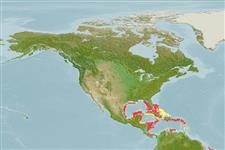Parapallene bermudensis Lebour, 1949
| Native range | All suitable habitat | Point map | Year 2050 |

|
| This map was computer-generated and has not yet been reviewed. |
| Parapallene bermudensis AquaMaps Data sources: GBIF OBIS |
Загрузить свой Фото
Изображение на Google |
No photo available for this species.No drawings available for Callipallenidae.
Изображение на Google |
No photo available for this species.
Classification / Names Common names | Synonyms | CoL | ITIS | WoRMS
| Pantopoda | Callipallenidae
Environment: milieu / climate zone / depth range / distribution range экология
; пределы глубины 27 - 55 m (Ref. 2115). Tropical
распространение страны | регионы FAO | Ecosystems | места находок | интродукции
Western Central Atlantic and Indo-West Pacific.
Length at first maturity / Size / Вес / Возраст
Maturity: Lm ? range ? - ? cm
Краткое описание морфология
Trunk slender, long; neck very long, with few short spines at insertion of chelifores and proboscis. Cephalic segment longer than posterior 3 segments combined; glabrous lateral processes short, little longer than their diameters. Ocular tubercle low, apex with slender, anterior-pointing tubercle; eyes large. Proboscis short, with setose oral fringe. Abdomen short, erect, with 2 short lateral setae. Chelifores short; scapes with 1 long endal spine, several short ectal spines; chelae palms short, rounded, setose; fingers short, with several teeth. Palps lacking. Oviger long; fourth, fifth segments longest, subequal. Strigilis well developed, with denticulate spines and terminal claw. Legs very long, slender, lightly setose; second tibiae longest; propodus straight, with serrate heel spines matching those of tarsus and second tibia; claw robust; auxiliaries more than half main claw length (Ref. 2115, p. 61-62).
Epibiotic (Ref. 116112).
Life cycle and mating behavior половая зрелость | размножение | нерест | икра | Fecundity | личинки
Members of the class Pycnogonida are gonochoric and sexually dimorphic. During copulation, male usually suspends itself beneath the female. Fertilization occurs as the eggs leave the female's ovigers. Males brood the egg masses until they hatch. Life cycle: Eggs hatch into protonymphon larva then to adults.
Основная ссылка
ссылки | координатор | соавторы
King, P.E. 1973. (Ref. 12)
Статус Красного Списка МСОП (Ref. 130435)
Статус СИТЕС (Ref. 108899)
Not Evaluated
CMS (Ref. 116361)
Not Evaluated
Угроза для людей
Использование человеком
| FishSource |
инструменты
дополнительная информация
Возраст/Размеры
рост
Зависимость между длиной и массой тела
Зависимость между длинами
морфология
личинки
численность
рост
Зависимость между длиной и массой тела
Зависимость между длинами
морфология
личинки
численность
ресурсы в Интернет
BHL | BOLD Systems | CISTI | DiscoverLife | FAO(Publication : search) | Fishipedia | GenBank (Геном, Нуклеотид) | GloBI | Gomexsi | Google Books | Google Scholar | Google | PubMed | Tree of Life | Wikipedia (Вперёд, поиск) | Zoological Record
Estimates based on models
Preferred temperature
(Ref. 115969): 21.6 - 27.6, mean 25.5 (based on 36 cells).
Категория цены
(Ref. 80766):
Unknown.


